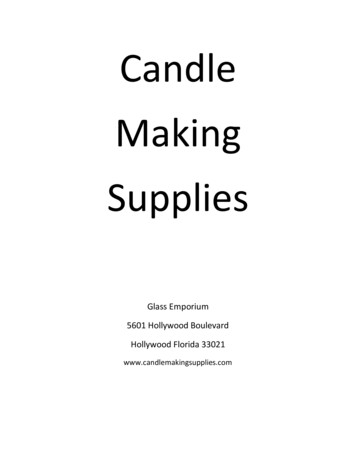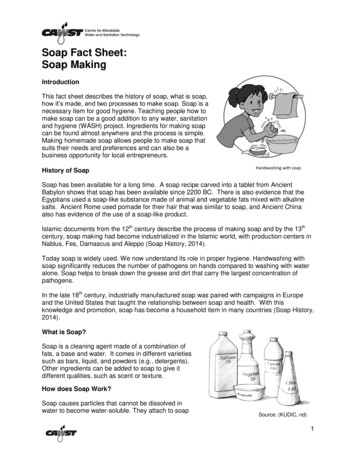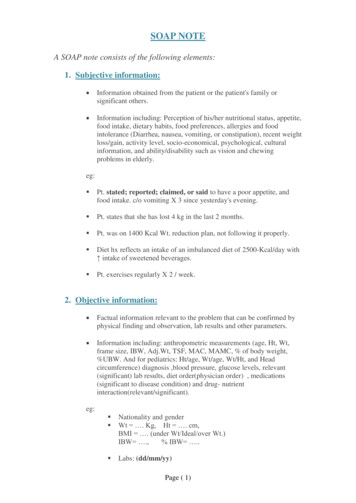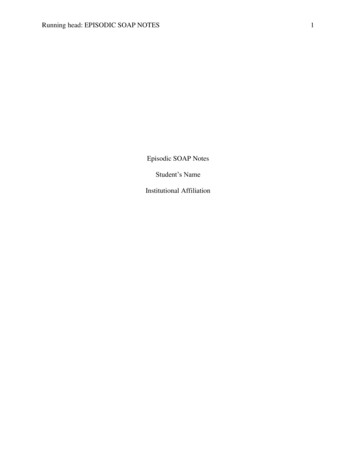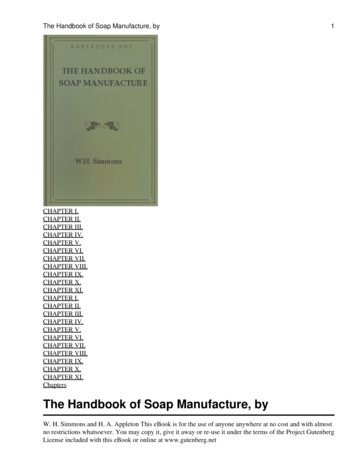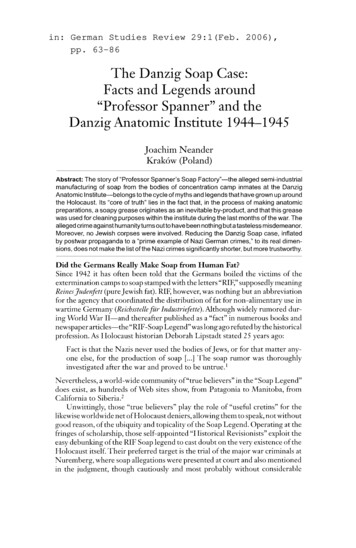
Transcription
in: German Studies Review 29:1(Feb. 2006),pp. 63-86Soap Case:DanzigFacts and LegendsaroundThe"ProfessorSpanner" and theAnatomicInstitute 1944-1945DanzigJoachim NeanderKrakow (Poland)The story of ry"?thefrom the bodiesinmatesat the Danzigof soapof concentrationcampmanufacturingto the cycle of mythsAnatomicand legendsthat have grown up aroundInstitute?belongsthe Holocaust.Its "core of truth" lies in the fact that, in the processof makinganatomicAbstract:a soapyas an inevitableand that this sed for cleaningwithinthe last monthsthe institute duringof the war. Thepurposescrime againstturns outto have been nothing but a tastelessmisdemeanor.allegedhumanityno Jewishwerethe ducingto a "prime exampleto its real dimenof Nazi Germancrimes,"by postwarpropagandanot makedoessions,thelist of the NazicrimessignificantlyDid the GermansSoap from HumanReally MakeSince f942 it has often been told that the Germansexterminationto soapcampsstampedwiththelettersbut moreshorter,Fat?boiled"RTF,"trustworthy.the victimssupposedlyof themeaningReines Judenfett (pure Jewish fat). RIF, however, was nothing but an abbreviationuse infor the agency that coordinated the distribution of fat for non-alimentarywartime Germanyrumoreddur(Reichsstellef?r Industriefette). Although ?thenewspaper"RIF-Soap Legend"bylong agohistorian Deborah Lipstadt stated 25 years ago:profession. As HolocaustFactoneelse,fortheproductionthe warafterinvestigatedNevertheless,neverthe Nazisis thata world-wideusedofandthebodiessoapprovedof "truecommunityof Jews,[.] Thesoapto be untrue.1orthat matterforrumorbelievers"wasin theanythoroughly"SoapLegend"fromsites show, from Patagonia toManitoba,does exist, as hundreds ofWebCalifornia to Siberia.2those "true believers" play the role of "useful cretins" for theUnwittingly,likewiseworldwidenetof Holocaustdeniers,allowingthemtospeak,not withoutat thegood reason, of the ubiquity and topicality of the Soap Legend. OperatingRevisionists"ofthose"Historicalexploit stenceof theRIF"doubtoftheveryeasy debunkingSoap legendLlolocaust itself. Their preferred target is the trial of the major war criminals atNuremberg,wherein the tedand mostat courtandprobably withoutalso mentionedconsiderable
64GermanStudies Review29/1 (2006)site of the "Institute for Historicaleffect on its tenor. On theWeba leading "Revisionist," gets to the point:Mark Weber,Research,"falsehoodslike the soap story [.] raise doubts aboutEasily demonstrablethe entire Holocaustlegend [.] and [.] the credibility of the [Nuremberg]Tribunal and other supposedly trustworthy authorities in establishing other,morefundamentalofaspectsthe Holocauststory.3The illogic of this reasoning is obvious: awell-documentedhistorical event suchas the Holocaustcannot be discredited by disproving amarginal topic like theof soap from the victims' bodies.alleged manufactureAt Nurembergdocuments were presented by the Soviets that seemed toSchool (Medizinischeprove that at the Anatomic Institute of the Danzig MedicalAkademie Danzig, today Akademia Medyczna Gdansk) the Germans had not onlyproduced dozens of kilograms of soap from human body fat, but were even aboutto doso ona massscale.from Februarysemi-industrialwere[.] The[.]Onlycrimeof19,FebruarythatSpanner:of soap from human bodiesI nowwhichsamplesstated1946,submitprovethat[.]the processsoap was already completely worked out in the Institute ofthe victorious advance of the Red Army put an end to thisof manufacturingnewonRudenko,1945 under professor Rudolfin the 4 until Januarythe Nazis.4Tribunal as a source ofhigh international reputation of the ejectSoap allegations areTheat least wouldconvinced?ornotaprioriatpreclude?thatthe GermansDanzigtrial runs in producing soap from human corpses, though only on ascale.5 Certainly many will agree with Holocausthistoriansmall, experimentalYehuda Bauer, who in 1990 stated: "It is also clear that had the war continued,did makewerethe orror."6The Danzig soap issue is firmly established inHolocaustremembrance. ForIsrael, presentsexample, Beit Lohamei Haghetaot (The Ghetto Fighters' House),at itsWeb site 26 pictures, "photographedin 1945" at the premises of the formerInstitute, as is asserted in the captions. Every picture bearsDanzig xperimentsproducesoapfromhuman fat. The bodies of inmates were supplied by the Stutthof camp."7A popular Jewish-American Website appears to give more detailed informacasebutmixesthewiththe RIF soap issue:tion,DanzigOneof the worstProfessorRudolfcrimes committedSpanner,an SSby the Naziesofficerand[sic] has been in Stutthof.'scientist',wasownerofa smallIn 1940, he invented a process to producesoap factory located in Danzig.fromhumanfat.ThissoapJudische [sic]'product' was called redsofinmateswereexecuted
65NeanderJoachimfor the 'production'FollowingSpanner was very proud of his invention.of soap. dandhoursto admire his 'invention'. At the liberation, the Allies discovered chambersfull of corpses used for the production of soap. After the war, Rudolf Spannerwasnotandhiscontinued'researchs'.8of students all over the world have been told ar-IIareandclasses,historysimilar inHolostilllearningit.discourse, "Professor Spanner'sIndependent of its position in the HolocaustSoap Factory" is deeply rooted in the collective memory of the Polish people.Since 1946/47, nearly every school child in Poland has read Profesor Spanner byZofia Nafkowskaand the references to soap-making from human bodies at ntly,museumsand memorialsites all over Poland exhibited cakes of soap allegedly made by the Germans fromtheir Polish victims.10 The Danzig soap and Professor Spanner are still used inanti-Germanpolemics,asin theheateddebateovera "CenteragainstExpulsions" and its promoter, Erika Steinbach, president of the German Associationof ExpelleesPolish(Bund der Vertriebenen).11 Stefan Bratkowski, a well-knownin Rzeczpospolita, one of Poland's leading dailies, whetherjournalist, wonderedErika Steinbach's daddy might have guarded transports of Stutthof prisonerson their way to Danzig to be boiled to soapby Professor Spanner, and whetherlittle Erika herself was washed with this soap.12Whatreally happened at the Danzig Anatomic Institute during the last yearof the war? Did the Germansthere in fact make soap from human corpses? Wasthere already a "small soap factory?" Did the Stutthof concentrationcamp supply the institute with corpses? Last but not least: what role did the head of theinstitute, Professor Spanner, play in this affair?in the Spring of 1945DiscoveriesHorribleTo trace the origins of the Danzig soap case it is necessary to go back to the lastdays ofWorld War II. Immediately after the capture of Danzig by the Red Armyat the end ofMarch1945, the newly installed Polish authorities took stock of theamedical doctor, andGermans' estate. Inmid-AprilNatkanski,1945,Wincentyabout two weeks later, Stanisiaw Byczkowski, a toxicologist, inspected the premisesof the Anatomic Institute, which had been abandoned by the German scientists atthe end of January 1945. In the morgue and in the "maceratorium,"13 hundreds ofcorpses and body parts in various stages of decomposition were rotting away intanks and vats. The whole premises were badly vandalized. Everywherelaboratoryequipment,around,of humanskeletons,partsas emicals,later.14yearsButscatteredand paperslaydiscovthe mostshockingand Byczkowski made were pieces of awhitishtoldemployeesinformedthe authorities,themwasprobably"soap"madeorally;fromno writtenhumanreportor grayish mass, whichfat. Bothhasscientistscomedownthento us.
66GermanStudies Review29/1 (2006)On May 4,1945, a first investigation commission, headed by the Soviet Deputyand the Polish Mayor of Gdansk, inspected the premises.15Military GovernorPolish participants included amedical doctor, members of the Security ServiceUBP16 and the police, politicians, and the journalist ("propagandist") StanislawStrabski. In the commission'sreport "a table with two kilograms of soap" isa former employee of thementioned. Withoutbeing asked, Aleksy Opi?ski,ainwholivedwoodenhut on the premises,Institute,neighboring Hygieniccommissiontheapproachedone white, whichcommissiontheandtwopresentedhe said had been producedabouta formerassistant,laboratoryofpiecesonesoap,in the AnatomicandyellowInstitute. HeMazur,Zygmunttoldwaswhosaid to have participated in the manufactureof this soap. The same day the UBParrested Mazur and committed him to the Gdansk prison.17A Polish commission, headed by anUBP officer, took a series of photographsontheonpremises,8,May1945,in the morguemostlyandthe maceratorium.Among the members of the commission was again Stanislaw Strabski, who thesame day drafted an article to be published in the first issue of the newspaperto Strabski, the discoveries at the DanzigDziennik Bahycki onMay 19.AccordingAnatomic Institute had finally and irrefutably proven that the Germans had boiledtheir victims to soap, as had been rumored all over Europe during the war, butdue to lack of evidence, could not be verified directly at the exterminationsites.18On May 11, the Presidium of the (Polish) Main Commissionfor the Investigation of German Crimes in Poland (Prezydium Gl?wnej Komisji do Badania ZbrodniNiemieckich w Polsce), headed by Deputy Prime Minister Jaroslaw Janusz, visitedtheinstitute,firstandforemostthe morgueandthe maceratorium.StanislawStrabski was again present. The next day they interrogated the witnesses AleksyOpi?ski and Zygmunt Mazur. A "recipe" for the making of soap from fat remainders, dated February 15,1944, was found. Mazur confessed to having made soapout of human fat according to this recipe and told details of thesoap-makingon Maythe vice-chairpersonofprocess. Back inWarsaw13, Zofia Nalkowska,thea e Provisionalbegan to write the short story Profesor Spanner, based on her Danin the Anatomiczig experience.19 The findings of theMain Commission?thatInstitute, under the direction of Professor Rudolf Spanner, soap was made fromParliament,humanfat for55 years. rquestionedin Polandall further action from the Polishencyclopedias,andschoolfor moreside and foundthantheirtextbooks.On May 16 and 17,1945, an expert commission?thefirst one?headedby ist(Soviet)Physicianing of two other medical doctors, an engineer, and an UBP agent, investigatedthepremisesandexaminedthecorpsesinthe morgueandthe maceratorium.A smaller Polish medical commissionfollowed on May 18 and 19.The "soap"does not seem to have been an issue for either commissionsince they did notmentionit in their reports. In the next days, all corpses were dissected to deter
Joachim67Neandermine the reasons for their deaths. Shortly thereafter, in June 1945, all humanremains were buried at the Holy Trinity Cemeteryin the immediate vicinity ofInstitute. This cemetery, situated in the triangle of today's Alejathe AnatomicandMariana Smoluchowskiegostreets,Zwyci?stwa, Marii SModowskiej-Curie,was destroyed in 1946 and transformed into a public park.20On May 28 a Soviet investigation commission, headed by theWar Prosecutor of the Second Belorussian Front, interrogated Zygmunt Mazur. He repeatedas the records ofhis statements ofMay 12 before the Polish Main Commission,theMay 28 interrogation show. Two weeks later, on June 11 and 12,Mazur wasagain interrogated by the same commission. He stated that he had obtained thefrom Professor Spanner on February 15, 1944, and"recipe" for soap-makingthat he himself had made soap from human fat according to this "recipe," thathe had washed himself with this soap, and that his mother had used this soapfor laundry. In the beginning of July 1945, the UBP presented Zygmunt Mazurto a group of foreign journalists. He repeated his statements about making soapfrom human fat. His confessions were quoted in the article "The Human SoapFactory of Gdansk" by A. Zaslavsky, which appeared in the English-languagenewspaper The Soviet News on Friday, July 13, 1945. The next day ZygmuntMazur was already dead.21 The cause of death most probably was typhoid fever,which ravaged at the Gdansk prison at that time.SourcesThethe sisaretherefrom May and June 1945, and Spanner'sports of the investigation commissionstestimoniesbeforetheDenazificationCourt and to the issions'theofreportsFlensburg police.successor institution, Instytut Pami?ci NarodowejCommission's(IPN InstituteinofNational Remembrance)Warsaw. The major findings are summarized in theappendix of Stanislaw StrajDski's booklet Mydlo z ludzkiego tluszczu (Soap from Human Fat), together with the names and ranks/professionsof the participants.22Therecords of the examinations of Zygmunt Mazur by the Soviets (May 28,11, and 12, 1945) were presented at the trial of the major war criminals asDocument USSR-197. They are inRussian and were not included p-makingwaspresentedatNurembergasDocument USSR-196,reprinted inEnglish translation in the "Blue Series, "vol. 39,463-64from theAnatomic Institute inunderthepp.heading "Official gSoap from (Human) 'FatRemainders' Dated 15 February 1944."The word "human" isnot in the German original.In 1945/46, the British undertookinvestigations "In theMatter of GermanWar Crimes and in theMatter of the Anatomy Institute Danzig." They examinedfive former prisoners of war who, for a certain time, had worked at the AnatomicInstitute: Lance Bombardier John Graham, Corporal William Anderson Neely,Sergeant Andrew Neil, Regular Bombardier Jack Sherriff, and Private John
68GermanStudies Review29/1 (2006)Henry Witton. Their affidavits are kept at the Public Record Office, Kew, underasfileWO311/275. Those ofWittonand Neely were presented atNuremberg"Documents USSR-2 64 and USSR-2 72, but are not included in the "Blue Series.In 1947/48, Rudolf Spanner was interrogated by the German criminal policein the matter of the Danzig Anatomic Institute. He also testified in 1946 beforethe DenazificationCourt. Records of his statements and of testimonies given byandcolleaguesformerstudentsare at theLandesarchivSchleswig-HolsteinischesinKiel, with copies at the archives of the Zentrale Stelle, Ludwigsburg,and theInstitut f?r ZeitgeschichteinMunich. The personal files of Spanner andMazurfrom the Danzig Medicalin Gdansk,School are at the Archiwum sfilearein facreproducedsimile in the book Zbrodnia na Via Mercatorum.Mof the premises of the AnatomicInstitute taken inMay andPhotographsJune 1945 by the Polish and Soviet investigation commissions have been widelypublished, often under titles such as "The Danzig Soap Factory," or as allegcamp. Several are included inMydlo zedly taken at the Stutthof concentrationdates, and locationsludzkiego tluszczu, with a list of photographers, witnesses,are also posted on theWebin the appendix. Photographssite of Beit Lohameibut withoutcertificationsof authenticity or identifying names ofHagethaot,dates,photographers,Far moreimportantsources,primaryandplaces.25for the publichowever,havebeentwoand scholarlysecondarydiscussionsones:thethan thesestatementoftheon February 19,1946,26Soviet prosecutor General R. A. Rudenko atNurembergand the short story Profesor Spanner by Zofia Nalkowska,first published in 1945and reissued in 1946 together with seven other short stories about German warcrimes in Poland in the small booklet Medaliony. Rudenko based his argumentthe(USSR-197),solely on the records of the examinations of Zygmunt Mazurtherein (USSR-196), and the statements of the former British"recipe" mentionedPOWs Wittonand NeelyIn addition, he presented(USSR-264)(USSR-272).Institute (USSR-393).pieces of "soap" found at the Danzig AnatomicMedalionyhasseennumerousreprintsand wastranslatedintoalllanguagesof the former Eastern Bloc, including German. A complete English translation,however, did not appear until 2000.27 Profesor Spanner recounts the investigationsof the Main Commissionin the matter of the "Danzig Soap," focusing on theexamination of Zygmunt Mazur, the main witness, on May 12, 1945. The storycorrespondslargely to that of StrajDski'sMydlo z ludzkiego tluszczu2* and withthe records of the later examinations ofMazur by the Soviet commission. ZofiaNalkowska'shigh reputation as awriter, which she had already achieved in to socialism,andthefactthat she personally participated as the deputy chair of theMain Commissioninits investigations at the Danzig Anatomic Institute, raised Profesor Spanner in theto the level of a first-rate historical source.29public perception
69NeanderJoachimat the SourcesFirst Critical Glancescritical examination of otedinconsistencies,Stra bskiAlreadystatementsbeforethe MainCommission.Mazur'sever,abovethatwassoapthe aim of developingMazur'soddThein Professorproducedas anbehaviorfor mass production,a far moreto hideattempthasbeenof titutefrom secondarycritics have focused on the records of the examinationpublished. MostMazur.of theto historicalis fundamentalAlthoughbodiesStra bski interpretedterriblesecret.30"Revisionists"Richard Harwoodand DietliebFelderer attacked e"theysoap-makingtions they cited from a popular chemistry book in order to prove the USSR-196document wrong, refers to a different kind of process. The scathing critiqueof the retired chemical engineer Robert Frenz, who posted his analysis of theonstatementsand Mazur's"recipe"a "revisionist"Website,32doesstandtoupscrutiny, but generally "revisionist" critics do not bother about details.refusal, mostly combined with aThey usually limit themselves to a againstThey only ridicule hbetakenseriously.Spanner's statements in his interrogations by the German Criminal Police orCourt in 1946-48 must be regarded with skepticism.before the DenazificationIt can be assumed that, as the accused, he tried to present himself in a favorableincriminate him. On the other hand,light and avoid saying things that mightthoseofthat sedagainst him should be taken seriously, especially if they are corroborated by thea Czech anatomist and victim of Nazi persecution.testimony of Hans Havlicek,The first widely known non-"revisionist"critique of the documents presentedat Nurembergin the "Danzig Soap" issue came in the 1990s from the newlyIn ainWashington.States Holocaust Memorial Museumestablished ntpartiesposition paperto the fact that the "recipe" USSR-196does not refer to human fat.Withregardto USSR-264and 272, they further note that "the reported testimony of twoInstitute whileBritish prisoners of war who worked at the Danzig ictoryon calapproachtothe"DanzigSoap Case" hitherto known is a series of articles by the Polish journalist TadeuszSkutnik, based on archival research in Gdansk and published in the beginningof 2000 in the regional daily newspaper Dziennik Bahycki under the headingProfessor Spanner."36 Skutnik reproaches the investiga"Accusing/Defending1945 for an anti-German bias, which led themtion commissionsof ts?withthe main witness, was preparedgoodfor "confession"reason?thatZygmuntby the Polish UBPand
70Studies ReviewGerman29/1 (2006)oeuvre is a work ofthe Soviet NKVD. He further reminds us that eyond any suspiliterary fiction,cion. His view is shared by three professors of the Akademia Medyczna Gdansk,Boleslaw Rutkowski (Nephrology andTransplan ta tion)JanuszMorys(Anatomyand Marek Grzybiakand Neurobiology),(Clinical Anatomy), who agree thatcourse ofSpanner only prepared skeletons for educational purposes,37 in theneverwasthe objective of Spanner'swhich a soap-like by-product appeared thatnot leastefforts. Six decades after the end ofWorld War tradition?wantsSchool richhavingstigmabeen the scene of "one of the worst crimes committed by the Nazis."Triggered by Skutnik's articles and the ensuing discussion in the local press,in Gdansk on Decemberthe Union of the German Minority3, 2001 asked thewasmadefrom NaziIPN to settle the question once and for all whethersoapvictims in Professor Spanner's institute. IPN's interim report of September 2005dismissed the (exonerating) German evidence as "storytelling." It held that the(incriminating) evidence presented by the British POWs "can be trusted." IPNconcluded that soap for cleaning purposes was intentionally produced at the institute from human corpse fat. Contrary towidely held opinion in Poland, however,IPN clearly stated that the institute was not involved in genocide and that therewasButno massproduction:it was notcertainlyA NewCriticalSourcecriticism,"It waskinda matterofof angenocideexperiment?disgusting,withthe aim ottakenyetintoconsiderationthatnoneoftheand not a singlewitnesses who were examined by the Polish Main Commissionmember ofthat Commission was an expert in the fields of anatomy or chemistry,and thelet alone in soap-making.39 The same holds for the British witnessesmembers of the Soviet commission that interrogated Zygmunt Mazur. Moreover,none of these commissionsthattook notice of the findings of other commissionsdid forensic investigations as of May16, 1945. The whole discussion about thecase has revolved around statements given and papers written by individuals withno expertise in the field of the issue about which they expressed their views.in the discussion thus far, is the political,A second aspect, also neglectedwithin which Spanner and the Danzigandframeworkeconomic,technologicalAnatomic Institute operated during the last year of the war. Academia long ago hasabandoned the Soviet-Marxist view that sawNational Socialism as the culminationof capitalist imperialism, a perspective that guided the investigation commissionsat Nuremberg.Scholars today look at theof 1945 and the Soviet prosecutionGermanwareconomy,its structure,its prioritiesandin a differentiated,morerealistic way. Should the Germans not have preferred making glycerin for explosives or lubricants for combat vehicles from human fat, as British World-War-Ipropagandasoap. Didhadonceclaimed?Warsthey need to developare wona processwithtanksandfor soap-makingammunition,not withfrom human fat at all?
71NeanderJoachimThe remainder of this analysis will therefore analyze the key statements, claims,and allegations in the primary and secondary sources. In fact, wishful thinking andtomisinterprettheir discoveries, whichlack of expertise led the key commissionsin itself gave rise to further distortions of the facts and events in the literaturefor thethat followed. It should also be kept inmind that theMain cal body.dutyInvestigationthePolishdocument the crimes perpetrated by the Germanspeople. Itagainstwas in the interest of theMain Commissionand, indeed, of the fledgling Polishgovernment,provisionalto portraythe Germansin asanegativeaslightpossible.saw whatof the CommissionAt the Danzig AnatomicInstitute the membersthey wanted to see, and they heard from the witnesses what they wanted to hear.Their view of Professor Spanner and his institute, exemplified by CommissioninMedaliony, "made history."40member Zofia NalkowskaSoap, Fat, and Chemical MacerationSoap was a scarce commodity(Mangelware) inGermany and German-occupiedcountries during World War II. It was the main washing agent at that time andthe only agent that was used for personal hygiene. Rationing,together withto non-Germans,of minorand onlysmallersoapquotasqualityneverwereto conserve,shortforcedthat Germans,reallythoughguaranteedor sinceto supportat the timeis no evidenceeitherof soap. Therepresentedwereshortof soap or the raw materithat the Germansthe notionsufficientlycausetotoforhumanfat as a raw materialhadconsiderhaveals to makeit,farallottingthis fact was not known to the members of theMainObviouslywhorememberedthe marked shortage of soap in occupied PolandCommission,and most probably generalized from their experience.41its production.Soapcanbe producedfromeveryor animal,fat, vegetableandofcoursealsodoes not differ principally from thefrom human fat, which in its compositionfat of land mammals and would not pose additional difficulties to any process ofasoap-making.42 "Fat" is mixture of chemical compounds of glycerin and fattyandacids,"soap" mainly consists of sodium or potassium salts of those fattyacids.43 In the classical process of soap-making, known in principle in Europesince the late Roman period and used still today by hobby soap-makers andsmall-scalesoap-boilers,thefatis mixedwitha 25-35percentaqueoussolution of sodium hydroxide to obtain "hard" soap, or potassium hydroxide, whichyieldingyields "soft" soap. The alkali hydroxide reacts with the fat ning,theandessentialconditioningcomponentsare eadyfor use is obtained.44 The method of soap-making as described in the "recipe"is a primitive version of this classical process.USSR-196In the early 193 Os, however, German chemical plants had already gone over toin principle known since the middle of the nineteenthanother method,century,which allowed mass production on a high quality level and was better suited for
29/1 (2006)Studies ReviewGerman72an industry with a broad product spectrum.45 In a first step, under high pressureare hydrolyticallyand with the aid of metal oxide catalysts, the fatmoleculessplitinto glycerin and fatty acids. Both are the source material for a broad variety ofin this production line is obtainedothers soap?whichsynthetic products?amongwithalkaliofacidshydroxides or carbonates.46fattyby saponificationAttime,Spanner'sthe Germanchemicalindustryanditswereengineersamongthe leaders in the field. They had long ago acquired the know-how necessary tomake soap on an industrial scale. They did not need a "layperson," a professorof anatomy, to "invent the wheel," especially if this "invention" was generallyknown since the times of Galenus (ca. 130-200 A. D.). Had the Russian and Polishtakenand all those who followed their conclusionsinvestigation [.]at"processwasstatedneverwouldthey[.] workedfacts,wasout"haveforit umed"theindustrialorhumanfat.otheranyBut there was this "half-finished and [.] finished soap" that General Rudenkoas Exhibit USSR-393,48If it really was found at thehad presented atNurembergwe should accept this as a fact?wherehad itInstitute?andAnatomicDanzigcome from? All witnessestestified that they saw the "soap" in the "suspicious"small brick building that was built in 1942 on the premises of the institute andno longerthat still today is called "theMaceratorium,"although for decades it hasbeen used for this purpose. From the beginning of 1944, parts of human corpses,especially whole limbs, were "macerated" here, that is, boiled down in heated tankswith alkali hydroxides for obtaining skeleton preparations, as Spanner had testifiedtaken by the first commission, whichin all postwar interrogations.49 Evidenceonthe maceratoriuminspectedcommissionthis. Thecorroborates4,1945,Maynoticed, "In the one-story building [.] two autoclaves for the boiling down ofhuman bones."50 In one of them there were still human body parts. It should for housingcompletehuman body, a fact that can easily be seen from the pictures of the interior of themaceratorium, which were taken onMay 8,1945, and which have been widely published, often under the misleading heading "Professor Spanner's Soap Factory."51About "chemical" maceration with alkali hydroxides we read in a paper preat a scientificin 2002sentedoncongresssea mammals:at aphydroxide [.] should be used at 0.5-1 % by weight and keptthetheheat110?FWithsource,proper[about 45?C].specimenproximatelycan be left tomacerate. A well-flensedspecimen can be degreased and void offlesh in three to five days [.]Potassium hydroxide slowly decomposes cartilage,PotassiumthereforeafterThestep cleaning,investment.initialsame methodof potassiumintervertebralsternebrae,[.] Pros: Onewasusedhydroxide,Cons:agoand flipperendsand bleaching,chemical-resistantRequires60 yearsoftendisks,degreasingat theDanzigthe cheaperAnatomicsodium urce.52Institute.Insteadtank,was used, which
73Nean
Soap Factory" is deeply rooted in the collective memory of the Polish people. Since 1946/47, nearly every school child in Poland has read Profesor Spanner by Zofia Nafkowska and the references to soap-making from human bodies at Stutt . hof inTadeusz Borows

